Epipen
Generic name: epinephrine injection
Brand names: EpiPen 2-Pak, EpiPen JR 2-Pak
Drug classes: Adrenergic bronchodilators, Catecholamines, Vasopressors
Medically reviewed by A Ras MD.
What are EpiPen and EpiPen Jr?
EpiPen and EpiPen Jr are disposable, prefilled automatic injection devices (auto-injectors) used to treat life-threatening, allergic emergencies including anaphylaxis in people who are at risk for or have a history of serious allergic emergencies. Each device contains a single dose of epinephrine.
EpiPen and EpiPen Jr are for immediate self (or caregiver) administration and do not take the place of emergency medical care. You should get emergency help right away after using EpiPen and EpiPen Jr. EpiPen and EpiPen Jr are for people who have been prescribed this medicine by their healthcare provider. The EpiPen Auto-Injector (0.3 mg) is for patients who weigh 66 pounds or more (30 kilograms or more).
The EpiPen Jr Auto-Injector (0.15 mg) is for patients who weigh about 33 to 66 pounds (15 to 30 kilograms). It is not known if EpiPen and EpiPen Jr are safe and effective in children who weigh less than 33 pounds (15 kilograms).
Description
EpiPen (epinephrine injection, USP) 0.3 mg and EpiPen Jr (epinephrine injection, USP) 0.15 mg are single-dose auto-injectors and combination products containing drug and device components.
Each EpiPen Auto-Injector, 0.3 mg delivers a single dose of 0.3 mg epinephrine from epinephrine injection, USP 0.3 mg/0.3 mL in a sterile solution.
Each EpiPen Jr Auto-Injector, 0.15 mg delivers a single dose of 0.15 mg epinephrine from epinephrine injection, USP 0.15 mg/0.3 mL in a sterile solution.
Each 0.3 mL in the EpiPen Auto-Injector contains 0.3 mg epinephrine, 1.8 mg sodium chloride, 0.5 mg sodium metabisulfite, hydrochloric acid to adjust pH, and Water for Injection. The pH range is 2.2-5.0.
Each 0.3 mL in the EpiPen Jr Auto-Injector contains 0.15 mg epinephrine, 1.8 mg sodium chloride, 0.5 mg sodium metabisulfite, hydrochloric acid to adjust pH, and Water for Injection. The pH range is 2.2-5.0.
Epinephrine is a sympathomimetic catecholamine. Chemically, epinephrine is (-)-3,4- Dihydroxy-α-[(methylamino)methyl]benzyl alcohol with the following structure:
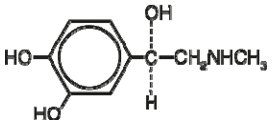
Epinephrine solution deteriorates rapidly on exposure to air or light, turning pink from oxidation to adrenochrome and brown from the formation of melanin. Replace EpiPen and EpiPen Jr if the epinephrine solution appears discolored (pinkish or brown color), cloudy, or contains particles.
Thoroughly review the patient instructions and operation of EpiPen or EpiPen Jr with patients and caregivers prior to use .
Mechanism of Action
Epinephrine acts on both alpha- and beta-adrenergic receptors.
What is the most important information I should know about EpiPen and EpiPen Jr?
1. EpiPen and EpiPen Jr contain epinephrine, a medicine used to treat allergic emergencies (anaphylaxis). Anaphylaxis can be life threatening, can happen within minutes, and can be caused by stinging and biting insects, allergy injections, foods, medicines, exercise, or unknown causes.
Symptoms of anaphylaxis may include:
- trouble breathing
- wheezing
- hoarseness (changes in the way your voice sounds)
- hives (raised reddened rash that may itch)
- severe itching
- swelling of your face, lips, mouth, or tongue
- skin rash, redness, or swelling
- fast heartbeat
- weak pulse
- feeling very anxious
- confusion
- stomach pain
- losing control of urine or bowel movements (incontinence)
- diarrhea or stomach cramps
- dizziness, fainting, or “passing out” (unconsciousness)
2. Always carry your EpiPen or EpiPen Jr with you because you may not know when anaphylaxis may happen.
Talk to your healthcare provider if you need additional units to keep at work, school, or other locations. Tell your family members, caregivers, and others where you keep your EpiPen or EpiPen Jr and how to use it before you need it. You may be unable to speak in an allergic emergency.
3. When you have an allergic emergency (anaphylaxis)
- Use the EpiPen or EpiPen Jr right away.
- Get emergency medical help right away. You may need further medical attention. You may need to use a second EpiPen or EpiPen Jr if symptoms continue or recur. Only a healthcare provider should give additional doses of epinephrine if you need more than 2 injections for a single anaphylaxis episode.
Other important information
- The EpiPen Auto-Injector has a yellow colored label.
- The EpiPen Jr Auto-Injector has a green colored label.
- The EpiPen Trainer has a grey color and contains no medicine and no needle.
- Your auto-injector is designed to work through clothing.
- The blue safety release on the EpiPen and EpiPen Jr Auto-Injector helps to prevent accidental injection of the device. Do not remove the blue safety release until you are ready to use it.
- Warning: Do not flip the blue safety release off using a thumb or by pulling it sideways, or by bending and twisting the blue safety release. This may cause the device to activate by accident: a “click” is heard, the orange tip is extended, and the window is blocked. A device that has been activated by accident cannot be used for a patient in an emergency. If this happens, replace it with a new EpiPen or EpiPen Jr.
- When receiving an EpiPen or EpiPen Jr Auto-Injector and before you need to use the EpiPen or EpiPen Jr Auto-Injector, remove the auto-injector from the carrier tube and check the auto-injector to make sure the blue safety release is not raised (see Figure 1 in the Instructions for Use). If the blue safety release is raised, the auto-injector should not be used because the device could activate by accident. Do not try to push the blue safety release back down. Put the auto-injector back in the carrier tube and replace it with a new EpiPen or EpiPen Jr.
- Choking hazard: The blue safety release is a small part that may become a choking hazard for children. Throw away the blue safety release immediately after using EpiPen and EpiPen Jr Auto-Injector.
- Only inject into the middle of the outer thigh (upper leg). Never inject into any other part of the body. • Never put your thumb, fingers, or your hand over the orange tip. The needle comes out of the orange tip.
- If an accidental injection happens, get emergency medical help right away.
- Do not place patient information or any other foreign objects in the carrier tube with the Auto-Injector, as this may prevent you from removing the Auto-Injector for use.
What should I tell my healthcare provider before using EpiPen or EpiPen Jr?
Before you use EpiPen or EpiPen Jr, tell your healthcare provider about all your medical conditions, but especially if you:
- have heart problems or high blood pressure
- have diabetes
- have thyroid problems
- have asthma
- have a history of depression
- have Parkinson’s disease
- have any other medical conditions
- are pregnant or plan to become pregnant. It is not known if epinephrine will harm your unborn baby.
- are breastfeeding or plan to breastfeed. It is not known if epinephrine passes into your breast milk.
Tell your healthcare provider about all the medicines you take, including prescription and over-the-counter medicines, vitamins, and herbal supplements. Tell your healthcare provider of all known allergies.
Especially tell your healthcare provider if you take certain asthma medicines.
EpiPen or EpiPen Jr and other medicines may affect each other, causing side effects. EpiPen or EpiPen Jr may affect the way other medicines work, and other medicines may affect how EpiPen or EpiPen Jr works.
Know the medicines you take. Keep a list of them to show your healthcare provider and pharmacist when you get a new medicine.
Use your EpiPen or EpiPen Jr for treatment of anaphylaxis as prescribed by your healthcare provider, regardless of your medical conditions or the medicines you take.
How should I use EpiPen and EpiPen Jr?
- Each EpiPen or EpiPen Jr Auto-Injector contains only 1 dose of medicine.
- EpiPen or EpiPen Jr should be injected into the middle of your outer thigh (upper leg). It can be injected through your clothing if needed.
- Read the Instructions for Use at the end of this Patient Information guide about the right way to use EpiPen and EpiPen Jr.
- Your healthcare provider will show you how to safely use the EpiPen or EpiPen Jr Auto-Injector.
- Use your EpiPen or EpiPen Jr exactly as your healthcare provider tells you to use it. You may need to use a second EpiPen or EpiPen Jr if symptoms continue or recur. Only a healthcare provider should give additional doses of epinephrine if you need more than 2 injections for a single anaphylaxis episode.
- Caution: Never put your thumb, fingers, or hand over the orange tip. Never press or push the orange tip with your thumb, fingers, or hand. The needle comes out of the orange tip. Accidental injection into finger, hands or feet may cause a loss of blood flow to these areas. If this happens, go immediately to the nearest emergency room. Tell the healthcare provider where on your body you received the accidental injection.
- Warning: Do not flip the blue safety release off using a thumb or by pulling it sideways, or by bending and twisting the blue safety release. This may cause the device to activate by accident: a “click” is heard, the orange tip is extended, and the window is blocked. A device that has been activated by accident cannot be used for a patient in an emergency. If this happens, replace it with a new EpiPen or EpiPen Jr.
- Your EpiPen and EpiPen Jr Auto-Injector may come packaged with an EpiPen Trainer and separate Trainer Instructions for Use. The EpiPen Trainer has a grey color. The grey EpiPen Trainer contains no medicine and no needle. Periodically practice with your EpiPen Trainer before an allergic emergency happens to make sure you are able to safely use the real EpiPen and EpiPen Jr Auto-Injector in an emergency. Always carry your real EpiPen or EpiPen Jr Auto-Injector with you in case of an allergic emergency. Additional training resources are available at www.epipen.com.
- Do not drop the carrier tube or auto-injector. If the carrier tube or auto-injector is dropped, check for damage and leakage. Dispose of the auto-injector and carrier tube, and replace if damage or leakage is noticed or suspected.
What are the possible side effects of EpiPen and EpiPen Jr?
EpiPen and EpiPen Jr may cause serious side effects.
- The EpiPen or EpiPen Jr should only be injected into the middle of your outer thigh (upper leg).Do not inject the EpiPen or EpiPen Jr into your:
- veins
- buttocks
- fingers, toes, hands, or feet
If you accidentally inject EpiPen or EpiPen Jr into any other part of your body, go to the nearest emergency room right away. Tell the healthcare provider where on your body you received the accidental injection.
- Rarely, patients who have used EpiPen or EpiPen Jr may develop infections at the injection site within a few days of an injection. Some of these infections can be serious. Call your healthcare provider right away if you have any of the following at an injection site:
- redness that does not go away
- swelling
- tenderness
- the area feels warm to the touch
- Cuts on the skin, bent needles, and needles that remain in the skin after the injection, have happened in young children who do not cooperate and kick or move during an injection. If you inject a young child with EpiPen or EpiPen Jr, hold their leg firmly in place before and during the injection to prevent injuries. Ask your healthcare provider to show you how to:
1. Hold the young child firmly in place (restrain).
2. With one hand, grip the auto-injector with the orange tip pointing down.
3. With the other hand, pull the blue safety release straight up and away from the auto-injector. - If you have certain medical conditions, or take certain medicines, your condition may get worse or you may have longer lasting side effects when you use your EpiPen or EpiPen Jr. Talk to your healthcare provider about all your medical conditions.
Common side effects of EpiPen and EpiPen Jr include:
- fast, irregular or “pounding” heartbeat
- sweating
- headache
- weakness
- shakiness
- paleness
- feelings of over excitement, nervousness or anxiety
- dizziness
- nausea or vomiting
- breathing problems
These side effects may go away with rest. Tell your healthcare provider if you have any side effect that bothers you or that does not go away.
These are not all the possible side effects of the EpiPen or EpiPen Jr. For more information, ask your healthcare provider or pharmacist.
Call your healthcare provider for medical advice about side effects. You may report side effects to FDA at 1-800-FDA-1088.
General information about the safe and effective use of EpiPen and EpiPen Jr
Medicines are sometimes prescribed for purposes other than those listed in a Patient Information Leaflet. Do not use the EpiPen or EpiPen Jr for a condition for which it was not prescribed. Do not give your EpiPen or EpiPen Jr to other people.
This Patient Information guide summarizes the most important information about EpiPen and EpiPen Jr. If you would like more information, talk to your healthcare provider. You can ask your pharmacist or healthcare provider for information about EpiPen and EpiPen Jr that is written for health professionals.
For more information and video instructions on the use of EpiPen and EpiPen Jr, go to www.epipen.com or call 1-800-395-3376.
How should I store EpiPen and EpiPen Jr?
- Store EpiPen and EpiPen Jr at room temperature between 68° to 77° F (20° to 25° C).
- Protect from light.
- Do not expose to extreme cold or heat. For example, do not store in your vehicle’s glove box and do not store in the refrigerator or freezer.
- Examine the contents in the clear window of your auto-injector periodically. The solution should be clear. If the solution is discolored (pinkish or brown color) or contains solid particles, replace the unit.
- Always keep your EpiPen or EpiPen Jr Auto-Injector in the carrier tube to protect it from damage; however, the carrier tube is not waterproof.
- The blue safety release helps to prevent accidental injection. Keep the blue safety release on until you need to use EpiPen or EpiPen Jr.
- Your EpiPen or EpiPen Jr has an expiration date. Replace it before the expiration date. Throw away (dispose of) expired, unwanted, or unused EpiPen and EpiPen Jr in an FDA-cleared sharps disposal container. Do not throw away the EpiPen or EpiPen Jr in your household trash. If you do not have an FDA-cleared sharps disposal container, you may use a household container that is:
- Made of heavy-duty plastic,
- Can be closed with a tight-fitting, puncture-resistant lid, without sharps being able to come out,
- Upright and stable during use,
- Leak-resistant, and
- Properly labeled to warn of hazardous waste inside the container.
When your sharps disposal container is almost full, you will need to follow your community guidelines for the right way to dispose of your sharps disposal container. There may be state or local laws about how you should throw away used needles and syringes. For more information about safe sharps disposal, and for specific information about sharps disposal in the state that you live in, go to the FDA’s website at: http://www.fda.gov/safesharpsdisposalVisit the FDA’s website (https://www.fda.gov/drugs/safe-disposal-medicines/disposal-unused-medicines-what-you-should-know) for more information about how to throw away (dispose of) unused, unwanted or expired medicines.
Keep EpiPen and EpiPen Jr and all medicines out of the reach of children.
What are the ingredients in EpiPen and EpiPen Jr?
Active Ingredients: Epinephrine
Inactive Ingredients: sodium chloride, sodium metabisulfite, hydrochloric acid, and water.
Instructions for use
EpiPen
(epinephrine injection, USP) Auto-Injector 0.3 mg
EpiPen = one dose of 0.3 mg epinephrine, USP 0.3 mg/0.3 mL
EpiPen Jr
(epinephrine injection, USP) Auto-Injector 0.15 mg
EpiPen Jr = one dose of 0.15 mg epinephrine, USP 0.15 mg/0.3 mL
For allergic emergencies (anaphylaxis)
Read these Instructions for Use carefully before you use EpiPen or EpiPen Jr. Before you need to use your EpiPen or EpiPen Jr, make sure your healthcare provider shows you the right way to use it. Parents, caregivers, and others who may be in a position to administer EpiPen or EpiPen Jr Auto-Injector should also understand how to use it as well. If you have any questions, ask your healthcare provider.
Your EpiPen and EpiPen Jr Auto-Injector
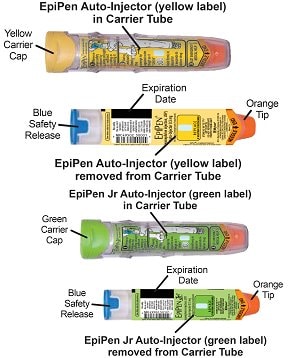
When receiving an EpiPen or EpiPen Jr Auto-Injector and before you need to use the EpiPen or EpiPen Jr Auto-Injector, do the following:
- Remove the EpiPen or EpiPen Jr Auto-Injector from the carrier tube and check the auto-injector to make sure the blue safety release is not raised (see Figure 1). If the blue safety release is not raised, the auto-injector is okay to use. Put the auto-injector back in the carrier tube so that it is ready to be used in an allergic emergency.
- If the blue safety release is raised (see Figure 2), the auto-injector should not be used because the device could activate by accident. Do not try to push the blue safety release back down. Put the auto-injector back in the carrier tube and replace it with a new EpiPen or EpiPen Jr.
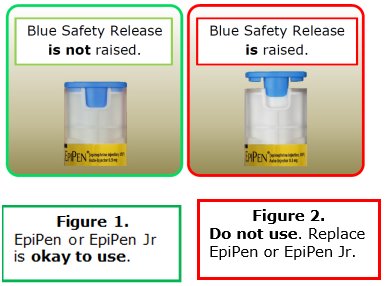
A dose of EpiPen or EpiPen Jr requires 3 simple steps: Prepare, Administer and Get emergency medical help
Step 1. Prepare EpiPen or EpiPen Jr for injection
| Remove the EpiPen or EpiPen Jr from the clear carrier tube. | |
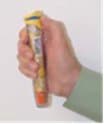 |
Open the yellow cap of your EpiPen or the green cap of your EpiPen Jr carrier tube. |
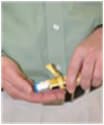 |
Tip and slide the auto-injector out of the carrier tube. |
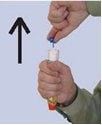 |
Grasp the auto-injector in your fist with the orange tip (needle end) pointing downward.
With your other hand, remove the blue safety release by pulling straight up without bending or twisting it. |
Warning: Do not flip the blue safety release off using a thumb or by pulling it sideways, or by bending and twisting the blue safety release. This may cause the device to activate by accident: a “click” is heard, the orange tip is extended, and the window is blocked. A device that has been activated by accident cannot be used for a patient in an emergency. If this happens, replace it with a new EpiPen or EpiPen Jr.
Important: The blue safety release is a small part that may become a choking hazard for children. Throw away the blue safety release immediately after using EpiPen or EpiPen Jr.
Note:
- The needle comes out of the orange tip.
- To avoid an accidental injection, never put your thumb, fingers or hand over the orange tip. If an accidental injection happens, get medical help right away.
Step 2. Administer EpiPen or EpiPen Jr
| If you are administering EpiPen or EpiPen Jr to a young child, hold the leg firmly in place while administering an injection. | |
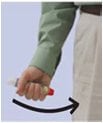 |
Place the orange tip against the middle of the outer thigh (upper leg) at a right angle (perpendicular) to the thigh. Swing and push the auto-injector firmly until it ‘clicks’. The click signals that the injection has started. |
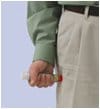 |
Hold firmly in place for 3 seconds (count slowly 1,2,3). The injection is now complete. |
 |
Remove the auto-injector from the thigh. The orange tip will extend to cover the needle. If the needle is still visible, do not attempt to reuse it. |
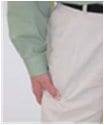 |
Massage the injection area for 10 seconds. |
Step 3. Get emergency medical help now.
You may need further medical attention. You may need to use a second EpiPen or EpiPen Jr Auto-Injector if symptoms continue or recur.
- Take your used auto-injector with you when you go to see a healthcare provider.
- Tell the healthcare provider that you have received an injection of epinephrine. Show the healthcare provider where you received the injection.
- Give your used EpiPen or EpiPen Jr Auto-Injector to the healthcare provider for inspection and proper disposal.
- Ask for a refill, if needed.
Note:
- The used auto-injector with extended needle cover will not fit in the carrier tube.
- EpiPen and EpiPen Jr are single-use injectable devices that deliver a fixed dose of epinephrine. The auto-injector cannot be reused. Do not attempt to reuse EpiPen after the device has been activated. It is normal for most of the medicine to remain in the auto-injector after the dose is injected. The correct dose has been administered if the orange needle tip is extended and the window is blocked.
- Your EpiPen and EpiPen Jr Auto-Injector may come packaged with an EpiPen Trainer and separate Trainer Instructions for Use. The EpiPen Trainer has a grey color. The grey EpiPen Trainer contains no medicine and no needle. Practice with your EpiPen Trainer, but always carry your real EpiPen or EpiPen Jr Auto-Injector in case of an allergic emergency.
- If you are administering EpiPen or EpiPen Jr to a young child, ask your healthcare provider to show you how to properly hold the leg in place while administering a dose.
- Do not try to take the EpiPen or EpiPen Jr Auto-Injector apart.
Label
PRINCIPAL DISPLAY PANEL – 0.3 MG
- NDC 49502-500-02
- Rx only
- For Allergic Emergencies (Anaphylaxis)
- EpiPen 2-PAK®
(epinephrine injection, USP)
Single-Dose Auto-Injectors 0.3 mg - Each carton contains:
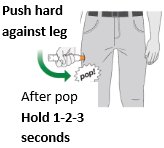
- The EpiPen Auto-Injector and Trainer are not toys and should be used under adult supervision.
- Never put thumb, fingers or hand over orange tip.
Do not remove blue safety release until ready to use. - EpiPen 2-Pak® contains 2 EpiPen® Auto-Injectors and 1 Trainer.
- Each EpiPen® Auto-Injector delivers one 0.3 mg intramuscular dose of epinephrine from epinephrine injection, USP 0.3 mg/0.3mL. Each 0.3 mL also contains 1.8 mg sodium chloride and 0.5 mg sodium metabisulfite.
- Discard unit after use. The Trainer contains no medicine and no needle.
- Read enclosed patient package insert carefully before using.
- Usual dosage: See insert.
- See enclosed Patient Information Leaflet for complete instructions for use.
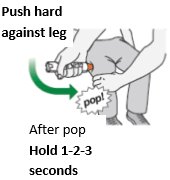
- Note: The needle comes out of the orange tip.
- Never put your thumb, fingers or hand
over the orange tip. - Replace if discolored. Store at 68º to 77ºF
(20º to 25ºC). Do not refrigerate. - Protect from light.
- Manufactured for Mylan Specialty L.P., Morgantown, WV 26505, USA
by Meridian Medical Technologies, Inc.,
Columbia, MD 21046, USA, a Pfizer company - EpiPen® or EpiPen Jr® are registered trademarks of Mylan Inc., a Viatris Company.
- Copyright © 2020 Meridian Medical Technologies. All rights reserved.
- 0002171
MS:50002:2C:R6 
PRINCIPAL DISPLAY PANEL – 0.15 MG
- NDC 49502-501-02
- Rx only
- For Allergic Emergencies (Anaphylaxis)
- EpiPen Jr 2-PAK®
(epinephrine injection, USP)
Single-Dose Auto-Injectors 0.15 mg - Each carton contains:
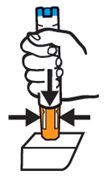
- The EpiPen Jr Auto-Injector and Trainer are not toys and should be used under adult supervision.
- Never put thumb, fingers or hand over orange tip.
Do not remove blue safety release until ready to use. - EpiPen Jr 2-Pak® contains 2 EpiPen Jr® Auto-Injectors and 1 Trainer.
- Each EpiPen Jr® Auto-Injector delivers one 0.15 mg intramuscular dose of epinephrine from epinephrine injection, USP 0.15 mg/0.3 mL. Each 0.3 mL also contains 1.8 mg sodium chloride and 0.5 mg sodium metabisulfite.
- Discard unit after use. The Trainer contains no medicine and no needle.
- Read enclosed patient package insert carefully before using.
- Usual dosage: See insert.
- See enclosed Patient Information
Leaflet for complete instructions for use.
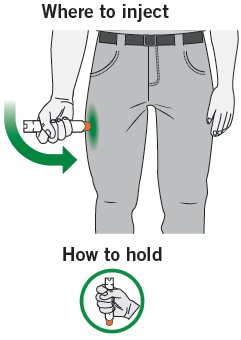
- Note: The needle comes out of the orange tip.
- Never put your thumb, fingers or hand
over the orange tip. - Replace if discolored. Store at 68º to 77ºF
(20º to 25ºC). Do not refrigerate. - Protect from light.
- Manufactured for Mylan Specialty L.P., Morgantown, WV 26505, USA
by Meridian Medical Technologies, Inc.,
Columbia, MD 21046, USA, a Pfizer company - EpiPen® or EpiPen Jr® are registered trademarks of Mylan Inc., a Viatris Company
- Copyright © 2020 Meridian Medical Technologies. All rights reserved.
- 0002172
MS:50102:2C:R6
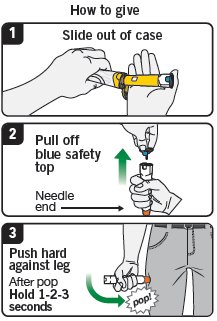
SRC: NLM .
